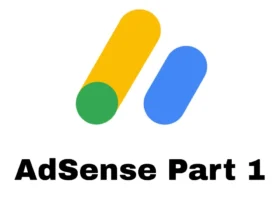Welcome to AdSense Part 4 — in this section, you’ll learn how to add a new post on your WordPress website the right way.
Creating high-quality, SEO-friendly, and AdSense-compliant articles is the most important step before your site gets approved. Google AdSense focuses on content quality, originality, and user experience.
Let’s go step-by-step through writing and publishing your first blog post that is ready for AdSense approval and monetization.
1. Importance of Quality Content for AdSense
Before you hit “Publish,” remember — content is everything.
AdSense doesn’t approve websites that:
❌ Have copied or AI-spun articles
❌ Contain too little content
❌ Lack structure or proper formatting
✅ Google wants:
- Original, helpful, and valuable information
- Articles with proper grammar and readability
- At least 15–20 quality posts before applying
💡 Pro Tip: Each article should have 800–1500+ words with headings, bullet points, and images.
2. Step 1: Log in to Your WordPress Dashboard
- Visit yourdomain.com/wp-admin
- Enter your username and password
- You’ll land on the WordPress Dashboard
This is where you manage posts, pages, plugins, and settings.
3. Step 2: Go to “Posts → Add New”
On the left sidebar:
- Click Posts → Add New
You’ll see the WordPress Block Editor (Gutenberg) — where you write and design your post.
4. Step 3: Add a Title and Content
Title Section:
Your post’s title should be:
- Clear, relevant, and keyword-rich
- Under 60 characters
- Example: “10 Easy Ways to Earn Money Online in 2025”
Content Section:
Use Headings (H2, H3) to organize your article.
Example Layout:
Title: 10 Easy Ways to Earn Money Online in 2025
Introduction
H2: 1. Freelancing
H2: 2. Blogging
H2: 3. YouTube Channel
H2: 4. Google AdSense
Conclusion
📌 Add paragraphs, lists, and images to make the content attractive and easy to read.
5. Step 4: Add Images and Media
Images make your posts engaging.
How to Add an Image:
- Click the “+” icon → Select Image Block
- Upload from your computer or use the Media Library
- Add alt text (e.g., “AdSense setup screenshot”) for SEO
💡 Use copyright-free images from:
Avoid copyrighted or watermarked images — it can cause AdSense rejection.
6. Step 5: Add Categories and Tags
On the right-hand side, you’ll see Post Settings.
Categories:
Organize posts into topics.
Example: “Tech”, “Finance”, “Blogging Tips”
Tags:
Add 4–6 keyword-related tags for SEO.
Example: AdSense, Blogging, Monetization, WordPress
7. Step 6: Use SEO Plugin to Optimize Your Post
If you have Yoast SEO or Rank Math installed, scroll down and optimize your post.
Basic SEO Settings:
✅ Add a Focus Keyword (e.g., “AdSense setup guide”)
✅ Write an SEO Title and Meta Description
✅ Ensure your keyword appears in:
- Title
- URL (slug)
- First paragraph
- 2–3 times throughout the content
💡 Keep your readability score green — short paragraphs and simple sentences.
8. Step 7: Add Internal and External Links
Google values well-linked articles.
- Internal links: Link to your own articles (e.g., “Read: AdSense Part 3 – WordPress Setup”).
- External links: Link to trusted sites (like Google, Wikipedia).
This helps Google understand your content better and boosts ranking.
9. Step 8: Insert AdSense Ads (After Approval)
If your site is already approved, you can insert AdSense code into your posts.
Using Ad Inserter Plugin:
- Go to Settings → Ad Inserter
- Paste your AdSense code in the desired block (e.g., after paragraph 2 or 4)
- Save and preview your post
For unapproved sites, don’t add ads yet — wait until Google approves your domain.
10. Step 9: Add a Featured Image
Every post should have a featured image (thumbnail).
Steps:
- On the right side → Scroll to Featured Image
- Upload a relevant image (size: 1280×720 recommended)
- Add a short alt description
This image appears on your homepage, social shares, and search previews.
11. Step 10: Publish Your Post
Once everything looks good:
- Click Preview to see how it appears
- If satisfied, click Publish → Publish again
Your post is now live on your website!
12. Step 11: Share and Index Your Post
After publishing:
✅ Share your post on social media (Facebook, Twitter, LinkedIn)
✅ Submit your post URL in Google Search Console → URL Inspection → Request Indexing
This helps Google crawl and show your post faster in search results.
13. Step 12: Repeat and Maintain Consistency
Publish 3–5 posts per week consistently.
Focus on high-quality, helpful content — that’s the key to AdSense approval and growth.
📈 Remember:
- Write content for readers, not bots
- Avoid keyword stuffing
- Keep updating old posts regularly
Conclusion
You’ve now completed AdSense Part 4 – Add New Post.
By following these steps, your blog posts will be:
✅ SEO-friendly
✅ AdSense-compliant
✅ Visually appealing
✅ Ready to earn revenue
In the next guide — AdSense Part 5 | Ad Placement & Optimization, we’ll cover:
🎯 Best ad positions for high CTR
💰 High CPC keyword targeting
⚙️ Advanced optimization strategies to boost income
Keywords: AdSense WordPress post, how to add new post in WordPress, AdSense content guide, AdSense approval tips, SEO WordPress post, AdSense blog writing, WordPress blogging tutorial 2025

